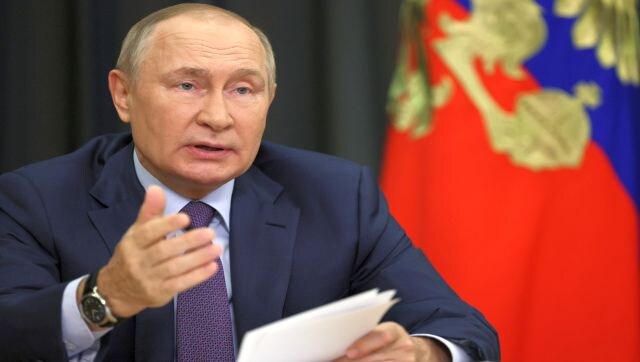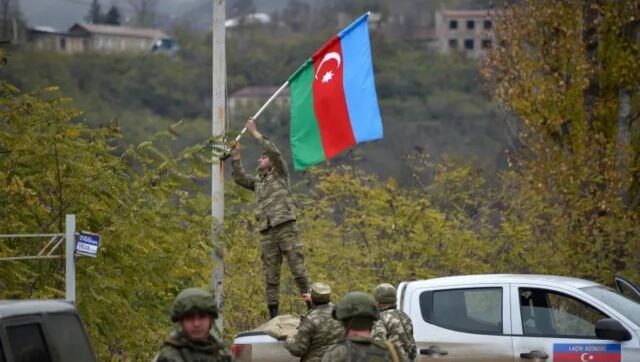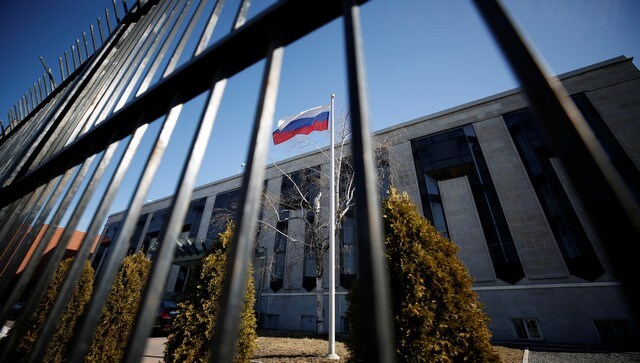Could a desperate Russia use a nuclear weapon in Ukraine?
The gains of use of a tactical nuclear weapon is too small and the risks of introducing nuclear weapons and nuclear fallout too huge

Russian president Vladimir Putin. AP
The United States warned of “catastrophic consequences” if Moscow were to cross the line and use nuclear weapons in Ukraine, after Russia’s foreign minister said that regions holding referendums would get full protection. Russia is conscious of possible Western support for Ukraine to retake the lost territory. It could raise the risk of a direct military confrontation between Russia and NATO.
Earlier, after a few battlefield losses in eastern Ukraine, Russian President Vladimir Putin had issued an ambiguous yet threatening warning to use a nuclear weapon. “If the territorial integrity of our country is threatened, we will without a doubt use all available means to protect Russia and our people,” he said in a nationally televised speech. “This is not a bluff.” There is already talk in Europe to build a nuclear arsenal to deter Russia’s nuclear threat. The only country ever to have used atomic bombs was the US in 1945 to strike Hiroshima and Nagasaki, ostensibly to force Japan to surrender in World War II.

The Little Boy bomb dropped over Hiroshima from B-29 Bomber Aircraft ‘Enola Bay’ on 6 August 1945
Understanding Tactical Nuclear Weapons
Related Articles
A tactical nuclear weapon (TNW) is a nuclear weapon designed to be used on a battlefield in military situations. It could involve use with friendly forces in proximity and perhaps even on contested friendly territory. The weapon has a relatively lower explosive power. The TNW could be in the form of gravity bombs, short-range missiles, or even artillery shells among many other means of delivery.
The “tactical” category is not clearly defined in terms of range or yield of the nuclear weapon. In fact, many experts disagree that there is actually a clear distinction between tactical and strategic nuclear weapons. Modern TNW could have yields from one kiloton or less, to as much as 100 kilotons. This is compared to 15 and 20 kilotons used in the atomic bombings of Hiroshima and Nagasaki respectively. One 100-kiloton nuclear weapon dropped on New York City could lead to roughly 583,160 fatalities, it is estimated. One can thus imagine the destructive power of a TNW. Yet each side does have some very small TNWs that can cover areas of jurisdiction of a typical Army Battalion or Brigade. But casualties from radiation and fallouts for years ahead could be huge. The area once nuked cannot be easily occupied or governed for a considerable period of time.
The risk that use of TNW could lead to a rapid escalation to full use of strategic weapons necessitates greater transparency on possession of TNWs. During the Cold War, both the Soviet Union and the US had a significant TNW stockpile. At the end of the Cold War both sides withdrew most of their TNWs. It is estimated that both the US and Russia still possess around 250 and 1,000 TNW respectively. Countries like South Korea think that possession of TNW could provide a local strategic deterrent to North Korea’s growing nuclear arsenal. Unfortunately, the TNWs are not governed by any international agreement. Luckily, no TNW has ever been used in a combat situation.
Escalate to de-escalate approach
During America’s precision bombing campaign in Kosovo, Vladimir Putin, then-secretary of the Security Council of Russia, formulated a concept called “escalate to de-escalate”. It essentially meant using both tactical and strategic nuclear strike threats to de-escalate or cause an enemy to disengage from a conventional conflict threatening what Russia considers a strategic interest. Most experts feel that this does not lower the threshold for use of nuclear weapons by Russia.
核武器库存
据估计,re are approximately 13,080 nuclear warheads in the world today. Russia is known to have 6,257 nuclear weapons; USA 5,550; China 350 and expanding; France 290; United Kingdom 225; Pakistan 165; India 156; Israel 90; and North Korea estimated 50. Some of the Russian and American weapons have been retired but are still counted in the total arsenal as they have still to be dismantled. International treaties like the 1970 Nuclear Non-Proliferation Treaty (NPT), the 1972 Strategic Arms Limitation Treaty (SALT), and the 1991 Strategic Arms Reduction Treaty (START) attempt to reduce nuclear weapons and prevent proliferation.

Image courtesy Arms Control Association
No first use policy
No first use (NFU) policy is when a nuclear power formally refrains from the use of nuclear weapons or other weapons of mass destruction in warfare, except for a second strike in retaliation to an attack by an enemy power using WMDs. Though invoked in reference to nuclear mutually assured destruction, some countries, including India, apply it to chemical and biological warfare weapons too. China and India are currently the only two nuclear powers to formally maintain a NFU policy, pledges that the two made immediately on possessing nuclear weapons. NATO and many of its members have repeatedly rejected calls for adopting a NFU policy.
在冷战期间一个先发制人的核打击as commonly argued as a key option to afford NATO a credible nuclear deterrent, compensating for the overwhelming conventional weapon superiority enjoyed by the Soviet military. In 1982 Russian president Brezhnev had pledged that the Soviet Union would not use the nuclear weapon first. The same was dropped in 1993 by Russia. In 2000 Russian military doctrine stated that they reserve the right to use nuclear weapons “in response to a large-scale conventional aggression”.
Pakistan too has a similar position in reference to large conventional military superiority of India. North Korea has publicly pledged to refrain from a pre-emptive nuclear strike, while threatening full scale retaliation against conventional aggression. However, it is difficult to predict the actions of the autocratic North Korean regime.
Russia’s threats during Ukraine conflict
The war in Ukraine has led to a resurgence of fears about the use of nukes. Russian foreign minister Sergey Lavrov made a fairly direct statement recently at a news conference after addressing the United Nations General Assembly in New York City. When asked under what circumstances would Russia use nuclear weapons to defend the annexed regions, he said Russian territory, including territory “further enshrined” in Russia’s constitution in the future, “is under the full protection of the state”.
多数分析师认为,这种情况下只能be conceived if Russia was to suffer huge losses in Ukraine. The fact that Russia initiated partial military mobilisation in view of some significant territorial setbacks in occupied areas has brought the ‘N’ word back into posturing. But Russia too is conscious that the West is also hugely armed with Nukes. Any foolhardy act could escalate out of control. Russia meanwhile is banking on a much softer approach of democratic free world. Question is who will blink first, and whose bluff will be called.
Breaking the nuclear taboo
For nearly eight decades the use of nuclear weapons has been a taboo that was not broken by any side even in long face-offs and wars in Korea and Vietnam. Nukes remain a deterrent. Russia has in the past carried out military exercises simulating the use of TNW against NATO members. These could at best be for coercive signalling or doctrinal evaluation. Even in the unlikely case of Russia being completely pushed out of Ukraine, there will be no situation where Russia would lose its own territory. Therefore, there should be no trigger to use the nuclear weapon.
By using the ‘N’ word so often, is Russia exposing its conventional military force weakness against the West-backed Ukraine? Remember, Putin announced on 27 February 2022, just days after invading Ukraine, that he had moved Russia’s nuclear deterrent forces into alert. Russia has used its dual-capable hypersonic Kinzhal and the long-range Kalibr cruise missiles with conventional warheads. There are no indications, or intelligence inputs, that Russia has moved out any TNWs for preparation or mating.
Another debate that continues is that if Putin were to use a TNW on a non-NATO member, what would be the American response. Will the US take it as crossing of the never crossed line? Analysts say Russia’s goal in using a TNW in Ukraine would be to frighten it into surrender or submission to negotiations, and to divide the country’s Western backers. Another school of thought is that Moscow could achieve nuclear signalling by detonating a nuclear bomb over water, or make a high altitude explosion over Ukraine to generate an electromagnetic pulse to knock out electronic equipment, and in the process avoid casualties.
The US has warned of ‘catastrophic consequences’ and that it will ‘respond decisively’. Will that mean that NATO will enter the war, or will there be a nuclear response, are questions still as conjectures. There is a talk that Russian annexation itself raises the risk of a direct military confrontation between Russia and NATO. This would have to be watched in the next few days.

广岛原子弹之前和之后下降
Nuclear wars are much beyond individual egos of despotic leaders. They are the tools of the otherwise weak. Use of such weapons means annihilation of their own people too. There is no existential threat to Russia whatsoever. A powerful leader and his family and friends who enjoy high status and good life would not trade all that for total destruction. The world has withstood many such crises. At the peak of the Cold War, in 1986, the two sides had nearly 65,000 nuclear warheads. My assessment is the risk of nuclear weapon use may have gotten heightened, but remains low. They will remain veiled threats to pressurise adversary governments and to create public anxiety.
The gains of use of TNW will be too small and the risks of introducing nuclear weapons and nuclear fallout too huge. Putin and Russia are currently still victors, and are far from those levels of desperation that would necessitate use of TNW.
The writer is Director General, Centre for Air Power Studies. Views expressed are personal.
Read all theLatest News,Trending News,Cricket News,Bollywood News,
India NewsandEntertainment Newshere. Follow us onFacebook,TwitterandInstagram.
also read

Azerbaijan sets up checkpoint on key route to Armenia
"The units of the Azerbaijani Border Service established a border checkpoint on the sovereign territory of Azerbaijan, at the entrance of the Lachin-Khankendi road," the state border service said, adding it was a response to a similar move by Armenia

Russia advises citizens to avoid travelling to Canada amid rise in cases of discrimination against Russians
The advisory, dated April 20, was posted on the ministry's main Telegram channel on Saturday

South Korea's President says doors open for possible military aid to Ukraine
A key U.S. ally and a major producer of artillery ammunition, South Korea has so far tried to avoid antagonising Russia due to its companies operating there and Moscow's influence over North Korea, despite mounting pressure from Western countries for weapons supply.


